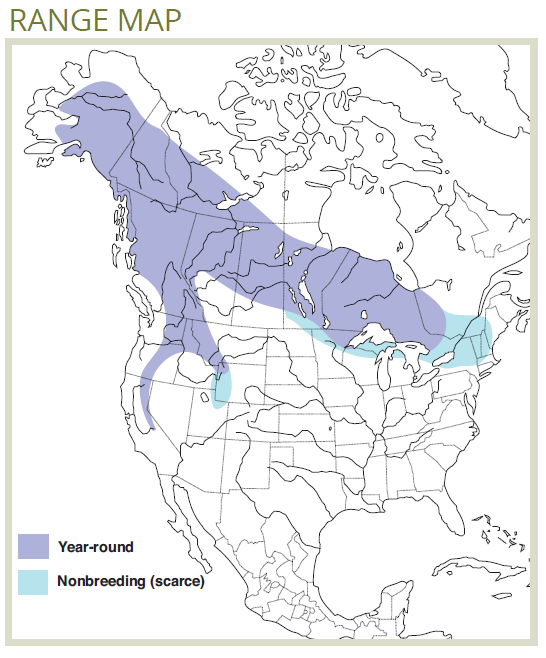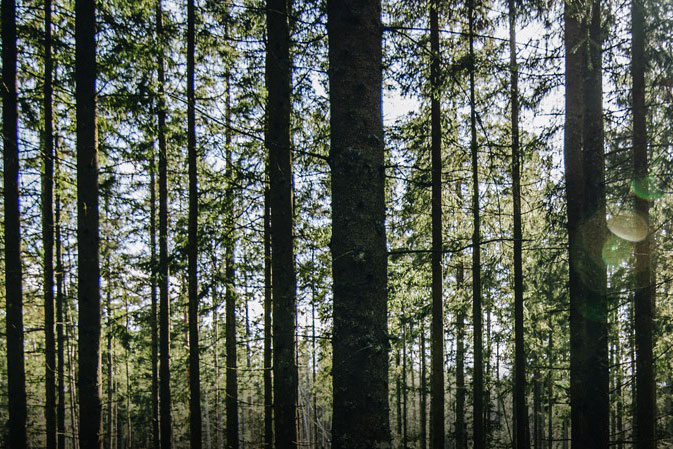The Great Gray Owl is a large, majestic owl that resides in northern coniferous forests, where it hunts for rodents in openings, meadows, and bogs.
Great Gray Owl
(Strix nebulosa)
Habitat Ecology
- The Great Gray Owl is a year-round resident found in open and mature coniferous forests, including dry pine stands,1 treed muskeg and black spruce/tamarack bogs,1 mature/old lodgepole pine and ponderosa pine forests near meadows,2 and riparian white spruce forest.3
- They often nest in old stick nests, broken-topped snags, or mistletoe brooms. Nests are located in forest patches larger than six hectares with ≥35% (preferably ≥60%) crown closure and leaning trees.2
- Great Gray Owls forage in open forests (≤40% closure of trees, saplings and shrubs),2 where they hunt for mice and voles from perches on trees or snags.4

Response to Forest Management
- Intensive forest management that removes large-diameter trees and snags, leaning trees, and opens the canopy is expected to negatively affect Great Gray Owls by reducing suitable nesting habitat.1
- However, Great Gray Owls are known to hunt in areas harvested using selective harvesting and clear-cutting.1
- Pathogen outbreaks, insect outbreaks, fire, and dwarf mistletoe infestations create high-value natural nest sites and patches of important nesting habitat features.4
Stand-level Recommendations
- Nesting habitat: Retention patches >6 ha are recommended within the harvested matrix, anchored around one or more stick nests, large-diameter broken-topped snags, and/or large mistletoe brooms. Patches should have >60% crown closure and contain leaning trees (which can be knocked over if not naturally occurring).2
- Great Gray Owl hunting flights are typically within 50 m of their perch. Planners and operators can increase the amount of available foraging habitat in a recent cut by leaving residual trees and patches roughly every 100 m.2,4
- Silviculture that reduces shrub cover may improve foraging habitat, but the rapid return of cover by seedlings or saplings will reduce available foraging area as the harvest block regenerates.2,4
Landscape-level Recommendations
- Burned/harvested areas are expected to provide foraging habitat for up to 20 years, provided there are residual patches and/or hunting perches. Dense shrub cover reduces foraging habitat value.4
- Nest sites are more likely to be limiting than foraging habitat, and maintenance of old coniferous stands >6 ha will be an important strategy, particularly within coniferous landscapes containing many wetlands or openings.5
- Wet areas containing black spruce and/or tamarack may represent quality habitat within the non-operable/unmerchantable landbase. Its value relative to harvested and old dense forest requires testing.
Knowledge Gaps
- Management recommendations for Great Gray Owl are inferred almost entirely from its known habitat ecology. Direct tests of this species’ responses to forest management are needed to inform more targeted management approaches.
References
- Bull, E. L. & Duncan, J. R. 1993. Great Gray Owl (Strix nebulosa). in The Birds of North America (Rodewald, P. G., ed.) Cornell Lab of Ornithology, Ithaca, New York, USA. Available online: https://birdsna.org/Species-Account/bna/species/grgowl
- Piorecky, M., Beck, B., Beck, J. & Bonar, R. 1999. Great Gray Owl year-round habitat: Habitat suitability index model (version 3). USDA Forest Service General Technical Report Available online: https://friresearch.ca/sites/default/files/null/HSP_1999_10_Rpt_GreatGra…
- Environment Canada. 2013. Bird Conservation Strategy for Bird Conservation Region 4 in Canada: Northwestern Interior Forest. Canadian Wildlife Service, Environment Canada, Whitehorse, Yukon. 138 pp. + appendices.
- Duncan, J. R. 1997. Great gray owls (Strix nebulosa nebulosa) and forest management in North America: a review and recommendations. Journal of Raptor Research 31: 160–166. Available online: https://sora.unm.edu/node/53603
- Environment Canada. 2013. Bird Conservation Strategy for Bird Conservation Region 6: Boreal Taiga Plains. Canadian Wildlife Service, Environment Canada, Edmonton, Alberta. 288 pp.








